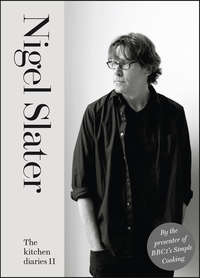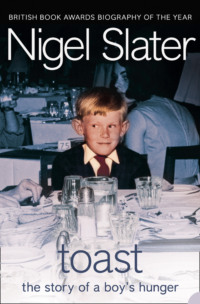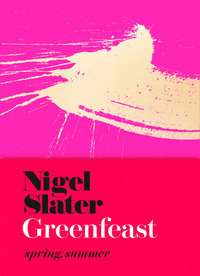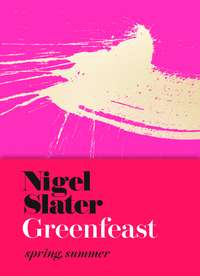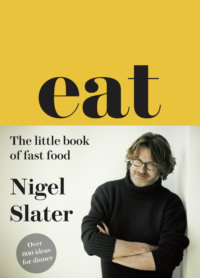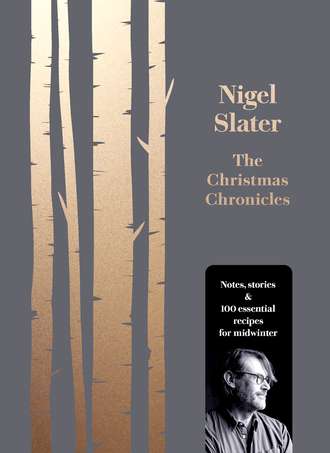
Полная версия
The Christmas Chronicles: Notes, stories & 100 essential recipes for midwinter
water – 1 litre
the juice of a lemon
quinces – 500g
green cardamom – 8 pods
mixed spice – 1 teaspoon
ground cinnamon – ½ teaspoon
golden sultanas – 200g
raisins – 200g
currants – 200g
dried apricots – 200g
light muscovado sugar – 100g
brandy or quince liqueur – 100ml
You will also need 3 × 400g jam jars, sterilised.
Put the caster sugar into a medium-sized saucepan, add the water and bring to the boil. Pour the lemon juice into the syrup. Peel the quinces, cut them into quarters, remove the core, then lower them into the pan. As soon as the syrup comes back to the boil, lower the heat to a simmer, partially cover the pan with a lid and leave for forty minutes, or until the quinces are soft but far from collapsing. Take off the heat.
Break open the cardamom pods, scrape out the seeds and crush them quite finely, using a pestle and mortar or spice mill. Put them into a capacious saucepan with the mixed spice and ground cinnamon. Add the golden sultanas, raisins and currants, then roughly chop the dried apricots and stir them in. Pour in 400ml of the quince cooking liquor and add the brown sugar. Simmer, stirring from time to time, for twenty minutes. Cut the quinces into small dice and add to the mincemeat. Pour in the brandy or liqueur, simmer for a further five minutes, then spoon into sterilised jars and seal.
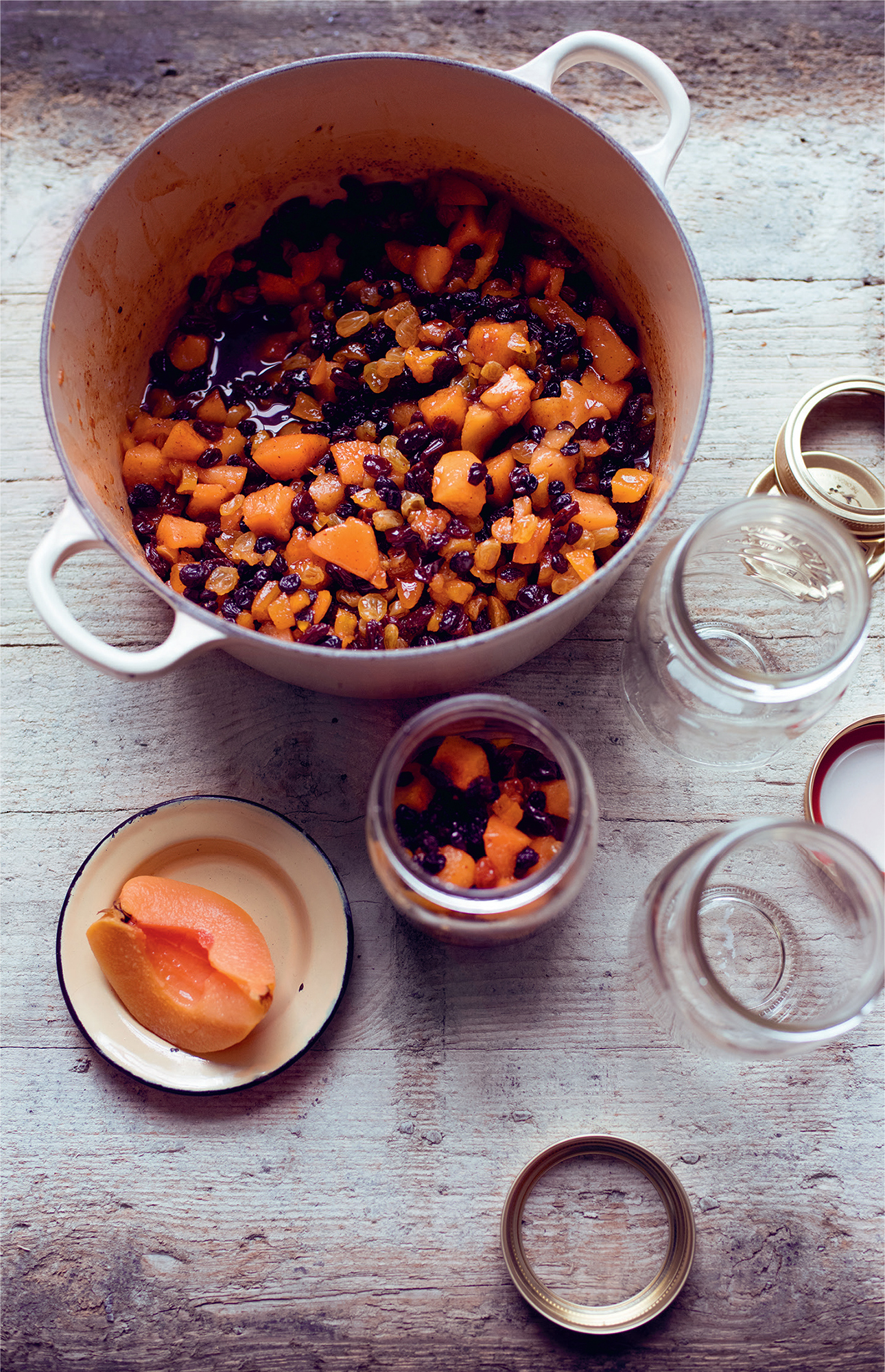
11 NOVEMBER
Martinmas, a ham dinner and a citrus cake
For centuries this has been a feast day. The date marked the end of the agricultural year, the harvest was well and truly in, the livestock were ready for slaughter, wine was ready for drinking. It is officially the beginning of winter. In medieval times, such an important feast was celebrated by eating a goose for those who could afford it, duck or chicken for those who couldn’t.
The celebration began in France, then spread to the Low Countries, Eastern Europe and then to Britain. It is still celebrated in Germany, with goose, dumplings and red cabbage. In parts of Scandinavia too, though to a much lesser extent, with lantern processions and singing, church services and, of course, feasting. In Britain we have traditionally eaten our goose on Michaelmas Day, September 29. But reading Martinmas in my diary does get me thinking about Christmas dinner and what will be on the table.
By now, many a working-class Victorian family like mine would have had a healthy collection of coins in their local Goose Club. This was a way of saving up for your festive food by stashing away as much as you could afford each week during summer, autumn and early winter, to help dilute the horror of the cost of Christmas. Each member of the clubs, which were run by publicans, groups of friends and butchers, would eventually get a goose and possibly some other treat into the bargain. Goose Clubs live on in the form of Christmas Clubs, though one usually only hears of them when they go bust, and everyone loses their hard-saved cash.
Today is, of course, Remembrance Day, Poppy Day, when we remember those who have died in the line of duty. I have breakfast at the Wolseley in London’s Piccadilly, where, on the dot of eleven, a full minute’s silence is observed by staff and customers. Hush falls on the enormous, high-ceilinged room; the staff stands still, not so much as a teaspoon tinkles in a saucer. I am moved almost to tears.
I have cooked a ham around this time of year for as long as I can remember. A practice run for the ham I will need over Christmas, that eternally useful cut-and-come-again joint for lunch, supper, sandwiches.
I usually take the route of simmering the rolled and tied joint in water or apple juice with peppercorns, cloves, celery, carrots and onions, then draining and baking it. The poaching keeps it moist, and the baking ensures a sticky crust, the surface of the ham usually having been spread with marmalade, apricot jam or honey.
This year I take the same route, but decide on quince paste – membrillo – as the sweet spread for the crust. The quince jelly is a good idea; it stays put in the oven, which is more than you can say for maple syrup or apricot jam, which you painstakingly paint over the meat only to find it slides off into the tin. The fruity-tartness is welcome with the sweet pink ham.
Ham with quince paste, cauliflower and dill
Serves 6 hot (with enough for a further 6 cold)
gammon, rolled and tied – 2.5kg
quince paste – 250g
dry Marsala or medium dry sherry – 4 tablespoons
For the stock:
an onion
cloves – 5
a cinnamon stick
black peppercorns – 10
bay leaves – 3
For the cauliflower:
cauliflower – 1.3kg
dill – 25g
Put the gammon into your largest saucepan or stockpot. Peel and halve the onion, then add it to the water along with the cloves, cinnamon stick, peppercorns and bay leaves. Bring to the boil, then turn down the heat and remove any froth from the surface of the liquid with a draining spoon. Partially cover with a lid and leave to simmer, gently, for an hour and a half. After an hour’s cooking, turn the meat over.
When the ham is ready, remove it from the cooking liquor and place it in a roasting tin, reserving the stock. Heat the oven to 200°C/Gas 6. Mix the quince paste and the Marsala or sherry in a small saucepan, letting it bubble briefly until it melts. Spread the paste over the ham. Bake for twenty-five to thirty minutes, or until the glaze has set. Remove and loosely cover with foil to keep warm.
While the ham bakes, break the cauliflower into florets and place in a saucepan. Ladle enough of the hot ham stock into the cauliflower pan to cover the florets, then bring to the boil – no need to add salt. Let the florets simmer until tender, about twenty to twenty-five minutes.
Remove half the cauliflower with a draining spoon and place in a warm, shallow dish. Put the remaining cauliflower and 200ml of the cooking stock into a blender with the dill (do not overfill – you may need to do this in two lots). Pour the cauliflower and dill purée over the cauliflower florets.
Serve the ham, carving it thinly, with the cauliflower. You will have plenty of ham left for tomorrow. Serve it with the apricot and tomato chutney recipe (see December 12, here).
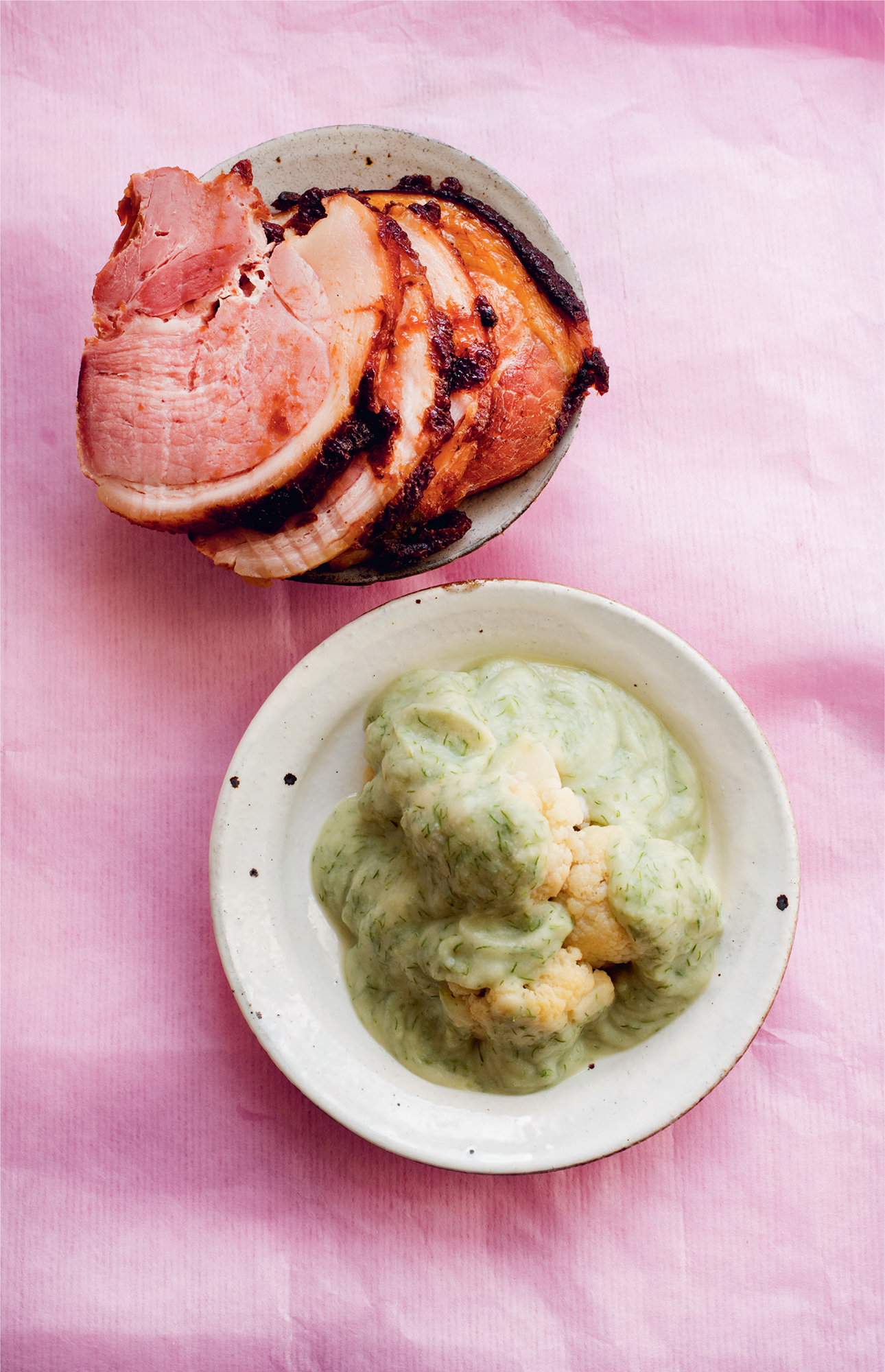
Orange poppy seed cake
It is also useful to have a cake that will keep in fine condition for several days. This soft, moist, citrus-scented loaf cake has the crunch of poppy seeds running through it.
Serves 8
soft butter – 225g
golden caster sugar – 225g
grated zest of an orange
grated zest of a lemon
plain flour – 110g
baking powder – generous ½ teaspoon
ground almonds – 115g
eggs – 4
poppy seeds – 20g
For the topping and syrup:
candied orange and citron peel
juice of the orange and lemon above
caster sugar – 75g
poppy seeds and golden sugar – 1 tablespoon of each
You will need a deep-sided, rectangular cake tin, 22cm × 12cm × 7cm deep, lined on the base and sides with baking parchment.
Set the oven at 180°C/Gas 4. Cut eight thin slices of the orange and citron peel, no thicker than 5mm, and the right size to sit on top of the cake, and set them aside. Put the butter into the bowl of a food mixer, add the caster sugar, and cream for a good five minutes until soft and fluffy. Add the orange and lemon zest. Sift together the flour and baking powder, then stir in the ground almonds.
Break the eggs into a small bowl and beat lightly with a fork to combine. With the beater at a moderate speed, add the eggs, a little at a time, to the butter and sugar. If the mixture appears to curdle slightly, add a spoonful of the flour and almond mixture. Continue adding the flour until thoroughly creamed. Mix in the poppy seeds.
Transfer the mixture to the lined cake tin, gently smoothing the surface flat. Place the slices of citrus peel on top of the cake. Bake for forty-five to fifty minutes, until a skewer, inserted into the cake, comes out without any raw cake mixture attached. Leave the cake to cool for ten minutes.
Make the syrup: put the orange and lemon juice into a saucepan and add the sugar. Bring to the boil, stirring until the sugar has dissolved. Still in its tin, pierce the cake in about twenty places with a metal skewer or a fine knitting needle. Spoon the citrus syrup over the surface, letting it trickle through the holes. Scatter the surface with poppy seeds and, if you wish, golden sugar crystals.
12 NOVEMBER
A pot roast partridge
We never had Champagne. At least not the real stuff. All that mattered was that a cork went pop and there were bubbles in our glasses. No one minded that what we drank was tummy-twistingly acidic and had bubbles the size of Maltesers. The point was noise and fizz. Asti Spumante had it with brass knobs on.
For a family on the quieter side – Mum, softly spoken as ever, with her calming there-there tone; Auntie Fanny, deaf as a post, who just sat and hummed to herself; and me, the little boy too scared to speak lest he upset his father – we nevertheless managed to make quite a bit of noise at the Christmas table. Dad was unusually loud, Mum got the giggles, brothers and aunties and grandmas were animated and chatted excitedly. Even the docile, flatulent golden retriever would run in circles around everyone’s legs. It never occurred to me that the table came to life because everyone was slightly pissed. We appeared, for once a year at least, like any other vast, happy family.
The year I was seven, Dad opened a bottle of the Italian fizz at the table, the cork flew across the room – a trajectory aimed at nowhere special – and contrived to hit one of my mother’s precious painted birds that lived on the wall over the fireplace, knocking the poor thing into an explosion of blue and yellow feathers. Mum laughed, yet I could see she was quietly fuming. The dog was coughing up feather-balls for weeks afterwards.
Birds pepper my winter eating like currants in a garibaldi. The goose or turkey at Christmas, of course, but weeks before that, the pheasants, grouse, a roast duck with apple sauce, maybe a quail or two. I like the deep flavours of game birds, the toasty bits in the bottom of the roasting tin; the accompaniments of redcurrant jelly, bread sauce and tiny sausages. I also relish the chance to tear my food apart with my hands. Much has to do with the shooting season, but the flavours are appropriate to the time of year, particularly when small birds are roasted with suitable vegetables, onions, mushrooms, parsnips and Jerusalem artichokes. And that medlar jelly you didn’t make, well, that is just the accompaniment for a roast pheasant or partridge too.
The most expensive of the birds is grouse and is something I tend to leave to restaurants. But the partridge does it for me. Expensive without being prohibitive, neat, lean and sweet-fleshed, they have a sense of jollity to them that I suspect comes from the carol. (There are no songs about a guinea fowl.) It is too early to think of partridges in pear trees but it is almost impossible to think of them without the rumbustious little tune coming into my head. The idea that one should be served on the first day of Christmas doesn’t really work, as we need a bigger bird for the attending family, so they are better pre or post Christmas.
The rhyme, ‘The Twelve Days of Christmas’, starts with a modest bird on Christmas Day and carries on through French hens and milking maids, getting grander with each of the twelve verses until we get to the leaping lords on Twelfth Night. An accumulative song – each verse builds on the previous ones – it was first published in Britain in 1870 and is thought to be of French origin. No one really knows how it started but it is generally considered to be a children’s game of memory and forfeit. I love the idea that the best-known version appeared in a children’s book called Mirth without Mischief (oh, for simpler times).
I have a pear and partridge recipe in Tender, Volume II. I take a more savoury route today, browning parsnips and onions before cooking them with a pair of little partridges and some chicken stock.
The clever trick and indeed the point behind pot-roasting is the small amount of liquid added to the casserole. Under a tight lid, the moisture produces steam that keeps the flesh of the birds juicy, circumnavigating the lack of fat that can make a traditionally roast bird dry. The roast partridge, by the way, is a tidy little dinner for one, and carries with it a faintly festive air. I eat them from early September (they come into season from the 1st) until early February (last shoot is the first day of Feb), often as a plain roast. Covered with bacon and smeared with dripping, they will roast to rose-tinted perfection in twenty-five minutes at 230°C/Gas 9. I tend to remove the bacon after ten minutes to give the breasts a chance to burnish. I throw in a chipolata or two if I’m feeling frivolous, or a slice or two of black pudding for the final ten minutes of cooking. Cabbage is a splendid accompaniment.
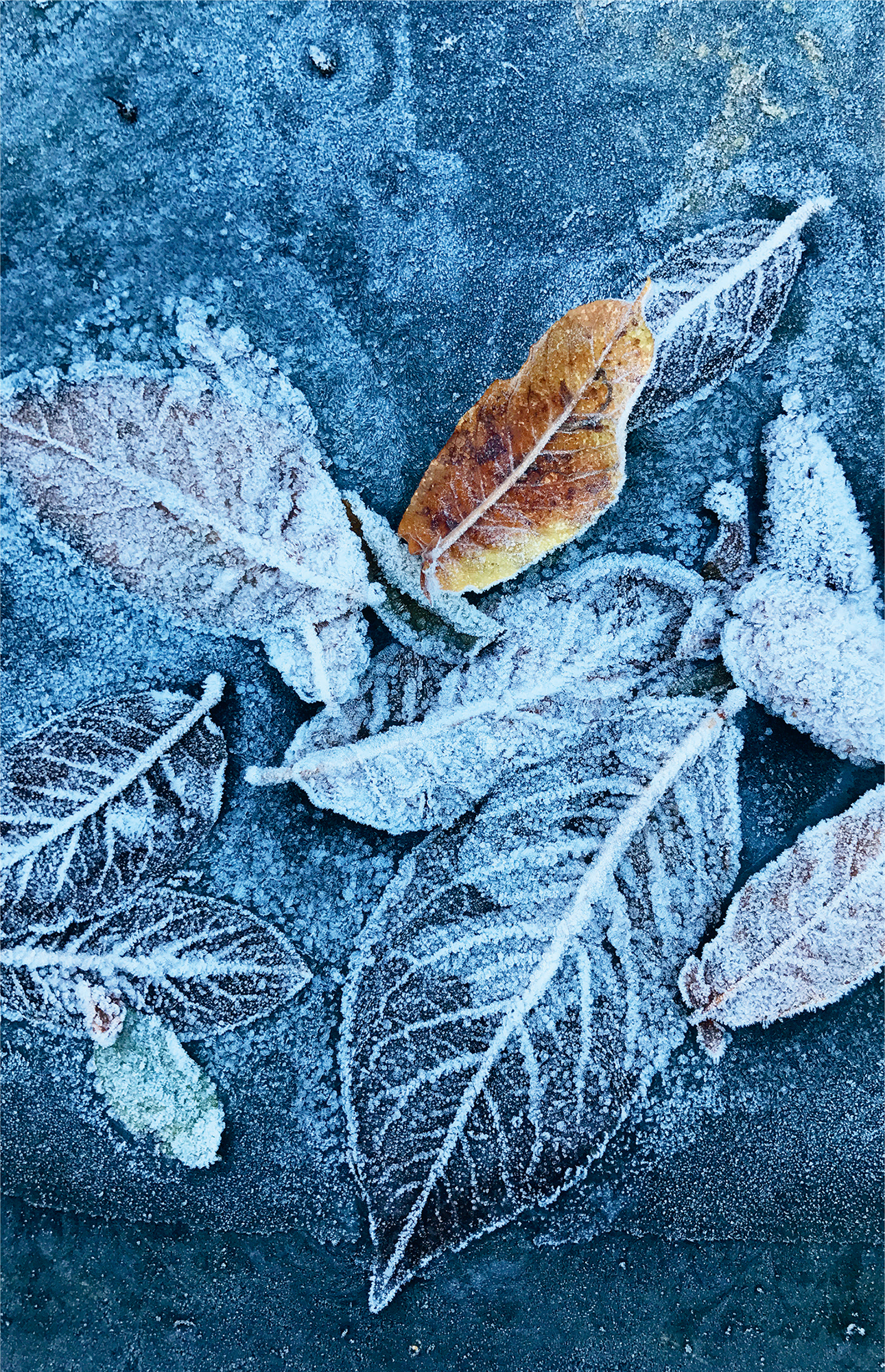
Pot-roast partridge with parsnips and smoked garlic
I am pot-roasting today’s birds with parsnips, juniper and smoked garlic.
Serves 2
banana shallots or small onions – 3
parsnips, medium – 2
smoked garlic – 4 cloves
olive oil – 3 tablespoons
partridges – 2
chicken stock – 250ml
thyme – 6 sprigs
juniper berries – 10
double cream – 125ml
Set the oven at 180°C/Gas 4. Peel the shallots and slice them in half lengthways. Peel the parsnips and cut them into chunks the length of a wine cork. Peel the garlic.
Warm the olive oil in a casserole for which you have a lid, lightly brown the shallots, parsnips and garlic in the hot oil, then remove. Season the birds with black pepper, then brown lightly in the oil. Remove the birds, pour in the stock and bring to the boil, scraping at any delicious debris in the pan and stirring it into the stock.
Return the birds and vegetables to the pot, tuck in the sprigs of thyme, and season with a little salt. Lightly crush the juniper berries and add them too. When everything returns to the boil, cover tightly with a lid and place in the oven for forty minutes. Remove the partridges, wrapping them in foil to keep them warm, then place the pot over a high heat and reduce the volume of liquid by half – it won’t thicken but will instead give you sweet, creamy juices. Stir in the cream, check the seasoning, then make sure all is thoroughly hot. Serve the birds in shallow bowls or deep plates, spooning over the vegetables and the juices. You will need a spoon as well as a knife and fork, and something with which to wipe your fingers.
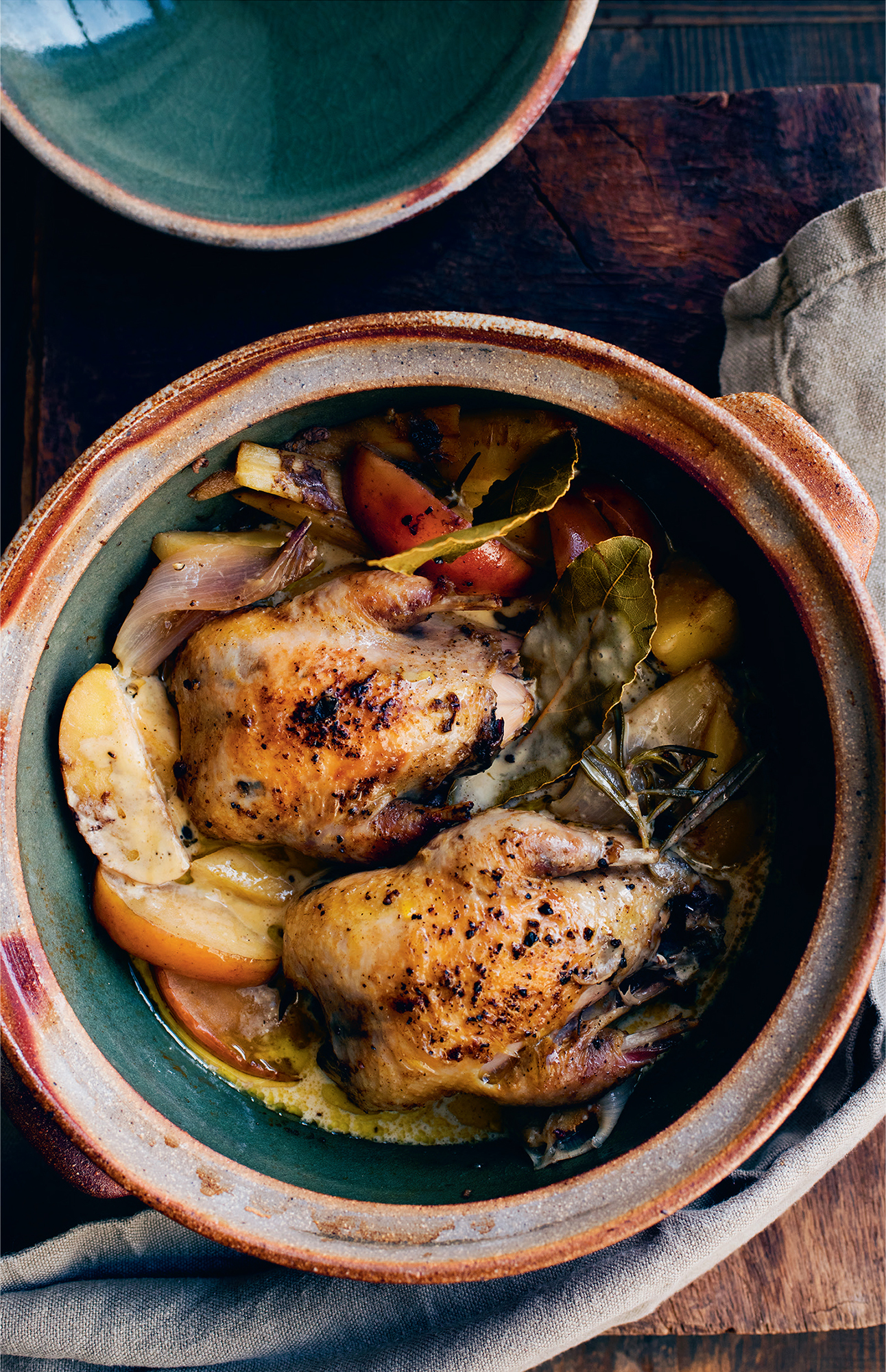
13 NOVEMBER
Maple syrup and fig terrine
The garden has skeletons – hydrangea, hornbeam and beech – holding their leaves even now. The pale walnut browns are smart and crisp against the green of the high yew hedges. Blue tits feast. Leaves, yellow, grey, black, lie frozen to the garden table, silver with frost. The space is tidy, but beneath the neatness lie worries. Two much-loved trees in the garden require major surgery, a third lost its leaves in the summer. The white jasmines, normally survivors in any garden, have suffered from a mysterious fungus. (This could well be due to their location, a curiously warm, damp courtyard where frost gets no hold, an enclosed space warm enough for pelargoniums to spend their winter unprotected.)
The garden needs a fierce snap of cold and so do I. The frost adds a touch of fairy-tale sparkle to the hedges and trees but it is still warm enough to venture out without a coat. I long for snow, for frost-ferns on the windows, for ice on the water butt.
I have been gardening long enough to know that there is much happening underground. Narcissi and tulips sprout, muscari and crocus are waking up. I feel this happening too. I feel in need of a prolonged cold patch to stir my own energy. Where some see a garden in repose, a sleeping beauty, I see what lies beneath, the garden’s hidden spirit, waiting to emerge.
This morning, after a couple of hours at my desk, I take out the secateurs and cut back the white roses, removing their spindly growth and confusion of crossed stems. Standing back to admire my work, I feel the roses can breathe once more. I come in, make coffee and set about sorting the larder – discarding and tidying. A sort of culinary pruning and removing of dead wood.
There is method in my madness. Even though this is the busiest time of year, I like to spend a day sorting out the food cupboards. A seasonal stock-take. A snapshot of what I have a little too much of (lentils, beans, coconut milk, maple syrup) and what I don’t have at all (light soy sauce, hoisin, honey and, crucially, dried yeast.) An inventory now means a slow picking up of necessities over the next few weeks rather than the horror and panic of a ‘big shop’ during Christmas week, when the rest of the country will be at it too.
There is only one way to tidy a kitchen cupboard and that is to take everything out. Everything. Moving things around from shelf to shelf and side to side doesn’t work. You need to see what you have, so I spend the rest of the morning with bottles, cans and storage jars spread over the floor. The shelves get cleaned, then everything goes back (or at least most of it), starting with the top shelf (dried beans and lentils), then working down.
I rather enjoy finding the oldest sell-by date, but the haul is a disappointment this time. A jar of chestnuts from two Christmases ago, a twelve-month over-the-date bag of prunes and a bottle of oyster sauce that seems magically to have escaped at least three previous stock-takes isn’t enough to satisfy me. I genuinely relish finding that box of coconut-flavoured sugar or jar of piccalilli that is old enough to have gone down on the Titanic.
A surfeit of maple syrup annoys me, though. It is one of the most expensive ingredients in the kitchen and I cannot imagine how I have ended up with three bottles. I put it down to the bottles being slim and stored sideways, thus becoming almost invisible, like a book in a bookshop with the spine facing out. This find does, however, give me the opportunity to try out an ice that may well end up on the table at Christmas.
Fig, maple syrup and Marsala ice cream
If you have an ice cream machine, churn the custard, syrup and yoghurt mixture first, then stir in the chopped fig and chocolate at the end. To prevent the custard from curdling, keep the heat low and, as it starts to thicken, remove from the heat, pour into a chilled bowl over ice or in a sink of cold water and beat firmly and continuously until most of the steam has gone and the custard is smooth. I like to serve the ice in chunks, like fudge, rather than in one large slab.
Serves 6
egg yolks – 4
caster sugar – 2 tablespoons
double cream – 450ml
vanilla extract – a few drops
maple syrup – 240ml
figs – 3
dark chocolate – 100g
thick, strained yoghurt – 200g
figs and physalis, to serve
Put the egg yolks and caster sugar into the bowl of a food mixer and whisk until light and fluffy. Warm the cream in a saucepan, switching the heat off just before it comes to the boil, then stir in the vanilla. Pour the warm cream on to the eggs and sugar and stir to mix. Rinse the saucepan, then pour in the egg and cream mixture and return to a low to moderate heat. Warm the custard, stirring regularly, until it starts to thicken slightly on the spoon, then pour into a cold bowl and stir or beat with a whisk to remove some of the heat. Leave to cool a little.
Pour in the maple syrup and combine. Chop the figs into small pieces, crushing them slightly as you go, then chop the chocolate into small, thin shards with a large knife. Stir the yoghurt, figs and chocolate pieces into the custard, then tip into a plastic freezer box and freeze for a good four hours, or overnight. Turn the ice cream out, then cut into large chunks and pile on to a chilled serving plate, perhaps with a few physalis and more slices of fig.
Dinner is a green and humble soup. The flavours are simple, the method is straightforward and the ingredients are everyday. Recipes like this, gentle, warming, unshowy and, it should be said, meatless, are the backbone of my eating. Yes, there is plenty to dazzle both plate and palate, but sometimes it is this sort of food I need, food without frills or fuss, calming, restorative and just a little bit nannying. Oh, and it has a flotilla of cheese and toast on top.
Cauliflower and leek soup with toasted cheese
I use whatever cheese is around for this sort of thing. Tonight, it is a mixture of Gorgonzola and Taleggio that needs using up, the two melting harmoniously over the pieces of toast. Use whatever you have.
Serves 4
leeks, medium – 3
butter – 30g
olive oil – 2 tablespoons
cauliflower – 1kg
vegetable stock – 1 litre
bay leaves – 2
parsley leaves – a good handful (10g)
sourdough bread – 4 slices
cheese (any good melting type) – 100g
Discard the coarse part of the green leaves from the leeks and roughly chop them. Warm the butter with the olive oil in a deep pan. Add the leeks and cover with a lid. Cook over a low to moderate heat, stirring and checking their progress regularly, until the leeks are soft but without browning them.
Trim and thickly slice the cauliflower and add to the leeks. Stir briefly, then pour in the vegetable stock and bring to the boil. Add the bay leaves and a little salt, then lower the heat and leave the leeks and cauliflower to simmer for fifteen to twenty minutes, until soft. Process half the mixture in a blender until really smooth. Add a handful of parsley to the remainder and process in the blender to a thick, rough-textured consistency. Mix the two together and check the seasoning, adding salt and ground black pepper as you think fit.
Spread the sourdough bread with a little butter or olive oil and place under a hot grill, toasting one side to a light crispness. Turn the bread over and cover the other side with thick slices of cheese, then return to the grill until melted. Divide the soup between shallow bowls and float the cheese toasts on top.
14 NOVEMBER
Candlelight and roast cabbage
I wake early, sit at my desk and write. A daily ritual which if missed sets my world briefly off its axis. For the best months of the year, it will still be dark, a prickle of cold in the air, the slightly-too-long arms of my sweater (my writing jumper, a dear old friend) slipping softly over my fingers as I type, as if I was wearing fingerless gloves.
I do most of my early morning writing by candlelight. There is a warmth to the light given by a single flame that no electric filament bulb can ever match, and shadows that flicker grey on white. Occasionally, in winter, the candles will gutter, the flame weaving a little as it burns, a flash, a hiss and a spit, as if someone has walked past, and then it steadies itself once more.
My love of candlelight has its history in the light given by a particular candle that would be burned at home, unfailingly, over Christmas, then put away again until the following year. A heavy, square, rough-sided candle, each side framing a paper stained-glass window. To this seven-year-old child, it seemed like a magic lantern, each window a door to a world in which wonderful things happened, but also a place of safety and warmth. A hollow in which to disappear, like a rabbit-hole or a wardrobe with a magical world past the fur coats.




